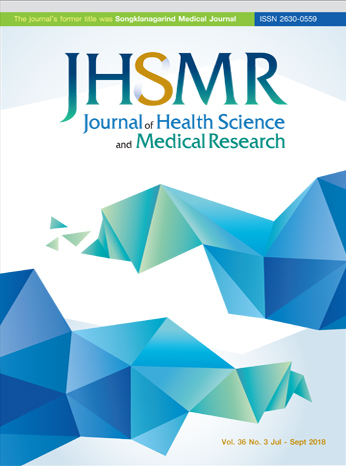Spontaneous Regression Rate of Low Grade Cervical Intraepithelial Lesions Diagnosed from Colposcopy
DOI:
https://doi.org/10.31584/jhsmr.2018.36.3.16Keywords:
ASC-US, CIN1, colposcopy, LSIL, spontaneous regressionAbstract
Objective: To evaluate the spontaneous regression rate and its associated factors of low grade intraepithelial lesions after colposcopy in Thai women.
Material and Methods: A retrospective study of the data of Thai women, not younger than 21 years old with liquidbased cervical cytology of atypical squamous cells of undetermined significance (ASC-US) or low-grade squamous intraepithelial lesions (LSIL), who had received colposcopic examination with histologically proven cervical intraepithelial neoplasia grade 1 (CIN1) or human papillomavirus (HPV) infection. All patients underwent cytologic tests as the follow-up method for at least 2 years at the Gynecology Clinic, Siriraj Hospital. Analyzed data included patient characteristics, cervical cytological and pathological results, colposcopic findings and evidence of cytological regression. The correlations between each variable and regression status were then measured.
Results: Data of a total of 154 patients who completed 2 years of follow-up were reviewed. One hundred and two patients had cytologic regression, showing a regression rate of 66.2%. There was 31.8% persistent abnormal cytology, and 2.0% progressed to high-grade cervical intraepithelial lesions. All patients with persistence or progression of cervical cytology had no invasive lesion. The only factor significantly related to cytologic regression was the pattern of colposcopic findings (p-value=0.041). The HPV-specific lesion on the colposcopy showed the significant pattern with an odds ratio of 3.5 (95% confidence interval=1.2-10.1, p-value=0.028).
Conclusion: Women who had initial cervical cytology of ASC-US or LSIL with colposcopic histological confirmation of CIN1 or HPV infection had spontaneous regression, about two-thirds within 2 years of follow-up time. Thus, conservative management in these patients should be considered.
References
2.National Cancer Institute, Department of medical services, Ministry of Public Health Thailand. Hospital based cancer register Annual Report 2012. Bangkok: Eastern Printing Public; 2014.
3.Schlecht NF, Platt RW, Duarte-Franco E, Costa MC, Sobrinho JP, Prado JC, et al. Human papillomavirus infection and time to progression and regression of cervical intraepithelial neoplasia. J Natl Cancer Inst 2003;95:1336-43.
4.Wright TC, Ferency AF, Kurman RJ, Precancerous lesions of the cervix. In: Kurman J, editor. Blaustein’s Pathology of the Female Genital Tract. 5th ed. New York: Springer Verlag; 2002;p.253-354.
5.Massad LS, Einstein MH, Huh WK, Katki HA, Kinney WK, Schiffman M, et al. 2012 Updated Consensus Guidelines for the Management of Abnormal Cervical Cancer Screening Tests and Cancer Precursors. J Low Genit Tract Dis 2013;17:1-27.
6.Cox JT, Schiffman M, Solomon D. Prospective follow-up suggests similar risk of subsequent cervical intraepithelial neoplasia grade 2 or 3 among women with cervical intraepithelial neoplasia grade 1 or negative colposcopy and directed biopsy. Am J Obstet Gynecol 2003;188:1406-12.
7.Katki HA, Gage JC, Schiffman M, Castle PE, Fetterman B, Poitras NE, et al. Follow-up testing post-colposcopy: fiveyear risk of CIN2+ after a colposcopic diagnosis of CIN1 or less. J Low Genit Tract Dis 2013;17:69–77.
8.Moscicki AB, Shiboski S, Hills NK, Powell KJ, Jay N, Hanson EN, et al. Regression of low-grade squamous intraepithelial lesions in young women. Lancet 2004;364:1678-83.
9.Smith MC, Keech SE, Perryman K, Soutter WP. A long-term study of women with normal colposcopy after referral with low-grade cytological abnormalities. BJOG 2006;113:1321-8.
10.Guido R, Schiffman M, Solomon D, Burke L. Postcolposcopy management strategies for women referred with low-grade squamous intraepithelial lesions or human papillomavirus DNA-positive atypical squamous cells of undetermined significance: a two-year prospective study. Am J Obstet Gynecol 2003;188:1401-5.
11.Wang PD, Lin RS. Risk factors for cervical intraepithelial neoplasia in Taiwan. Gynecol Oncol 1996;62:10–8.
12.Dalstein V, Riethmuller D, Pretet JL, Carval K, Sautiere JL, Carbillet JP, et al. Persistence and load of high-risk HPV are predictors for development of high-grade cervical lesions: a longitudinal French cohort study. Int J Cancer 2003;106:396–403.
13.Lee CH, Peng CY, Li RN, Chen YC, Tsai HT, Hung YH, et al. Risk evaluation for the development of cervical intraepithelial neoplasia: development and validation of risk-scoring schemes. Int J Cancer 2015;136:340-9.
14.Ho GY, Kadish AS, Burk RD, Basu J, Palan PR, Mikhail M, et al. HPV-16 and cigarette smoking as risk factors for highgrade cervical intra-epithelial neoplasia. Int J Cancer 1998;78:281–5.
15.Poomtavorn Y, Suwannarurk K, Thaweekul Y, Maireang K. Cervical cytologic abnormalities of cervical intraepithelial neoplasia 1 treated with cryotherapy and expectant management during the first year follow-up period. Asian Pac J Cancer Prev 2009;10:665-8.
16.Sangkarat S, Laiwejpithaya S, Rattanachaiyanont M, Chaopotong P, Benjapibal M, Wongtiraporn W, et al. Performance of Siriraj liquid-based cytology: a single center report concerning over 100,000 samples. Asian Pac J Cancer Prev 2014;15:2051-5.
17.Laiwejpithaya S, Benjapibal M, Laiwejpithaya S, Wongtiraporn W, Sangkarat S, Rattanachaiyanont M. Performance and cost analysis of Siriraj liquid-based cytology: a direct-to-vial study. Eur J Obstet Gynecol Reprod Biol 2009;147:201-5.
18.Laiwejpithaya S, Rattanachaiyanont M, Benjapibal M, Khuakoonratt N, Boriboonhirunsarn D, Laiwejpithaya S, et al. Comparison between Siriraj liquid-based and conventional cytology for detection of abnormal cervicovaginal smears: a split-sample study. Asian Pac J Cancer Prev 2008;9:575-80.
19.Hogewoning CJ, Bleeker MC, Brule AJ, Voorhorst FJ, Snijders PJ, Berkhof J, et al. Condom use promotes regression of cervical intraepithelial neoplasia and clearance of human papillomavirus: a randomized clinical trial. Int J Cancer 2003;107:811-6.
20.Sundstrom K, Lu D, Elfstrom KM, Wang J, Andrae B, Dilner J, et al. Follow-up of women with cervical cytological abnormalities showing atypical squamous cells of undetermined significance or low-grade squamous intraepithelial lesion: a nationwide cohort study. Am J Obstet Gynecol 2017;216:1–15.
21.Lee SS, Collins RJ, Pun TC, Cheng DK, Ngan HY. Conservative treatment of low grade squamous intraepithelial lesions (LSIL) of the cervix. Int J Gynaecol Obstet 1998;60:35-40.
22.del Pino M, Torne A, Alonso I, Mula R, Masoller N, Fuste V, et al. Colposcopy prediction of progression in human papillomavirus infections with minor cervical lesions. Obstet Gynecol 2010;116:1324-31.
23.Ostor AG. Natural history of cervical intraepithelial neoplasia: a critical review. Int J Gynecol Pathol 1993;12:186-92.
24.Bentley J. Colposcopic management of abnormal cervical cytology and histology. J Obstet Gynaecol Can 2012;34:1188–202.
























